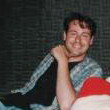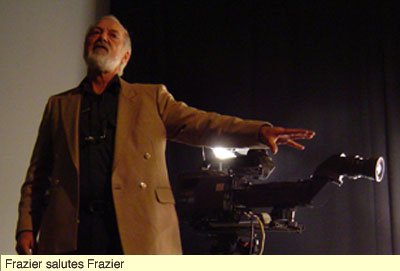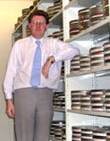|
|
This topic comprises 2 pages: 1 2
|
|
Author
|
Topic: Will Scope disappear?
|
|
|
|
|
|
|
|
|
|
|
|
|
Bobby Henderson
"Ask me about Trajan."

Posts: 10973
From: Lawton, OK, USA
Registered: Apr 2001
|
 posted 03-11-2007 12:57 PM
posted 03-11-2007 12:57 PM




quote: Ron Curran
Many people who speak d and e cinema are not interested in the 2.35 format. One tech told me that 35mm camera film was cropped for the Scope image, so 16x9 was the way of the future.
Those guys are being extremely ignorant of the creative side in having multiple framing formats. In fact they're spouting stupidity. Would it make sense for any painter or illustrator to stick to only one aspect ratio for his work?
There is no one single framing format that will serve a movie production to the best of its needs. Some movies are far better composed for the super-wide aspect ratio whereas others may seem more intimate shot flat or even in Academy ratio.
I think "common width" screens are a truly dumb idea, especially for the trends in theatrical aspect ratios over the past few years. I could be wrong, but it certainly seems like a lot more major releases are sent out in 'scope rather than flat.
There's even a lot of movies using the 'scope aspect ratio, such as a lot of small comedies and dramas, that would be better off framed flat. Just as "full screen" releases on DVD look to fill as much of the TV screen as possible, I think lots of productions are merely trying to do the same in commercial theaters when it comes to using Super35 and 'scope prints. My biggest complaint about this is many of those shows do not make the most of the 2.39:1 aspect ratio. Most seem to have bland compositions that try to play it safe for both home and theatrical viewing.
quote: Ron Curran
I gather that dci projection in 2.35 uses less information for Scope images.
'Scope in 2K D-Cinema does indeed have a lower pixel count than flat aspect ratio. But it's also interesting to note that none of the standard theatrical formats use all of the available pixels in the 2048 X 1080 sensor.
Frame formats capable from 2K digital projectors:
Flat: 1998 X 1080 (2,157,840 pixels)
Scope: 2048 X 858 (1,757,184 pixels)
Flat HD: 1920 X 1038 (1,992,960 pixels)
Scope HD: 1920 X 804 (1,543,680 pixels)
quote: Mark Gulbrandsen
There are also many other Super 35 films that look awesome, many have been blown up to 70mm, also wasn't Titanic Super 35? The 70mm prints looked dam good! The main reason for the format it because it affords better depth of field... or should I say the wide angle lenses the format uses offer more depth of field than any camera scope lens affords.
Only a very small percentage of all Super35 movies have blown up to 70mm. And not all looked great in 70mm either. James Cameron's movies, The Abyss in 1989, True Lies in 1994 and Titanic in 1997 are among the very best looking examples of Super35. I thought parts of Backdraft looked great as well (the same DP on The Abyss worked on that one).
However Super35 has a number of drawbacks. When dealing with 70mm, the optical enlargement step from the Super35 camera negative to 70mm must be handled correctly. James Cameron used customized Arri cameras, lots of custom made lenses and lots of different film emulsions to get the most detail out of the frame as possible.
I have seen lots of other Super35 movies that looked like grainy crap on the screen. Steven Soderbergh's remake of Oceans 11 is one that immediately comes to mind. I think Star Trek VI: The Undiscovered Country was the only one of that series to be shot in Super35. It also looked very grainy.
Spherical lenses do indeed have greater depth of field capability than an anamorphic lens in the same focal length and aperture size. However, anamorphic 'scope cinematography uses all of the 4-perf 35mm negative. Super35 uses a little over half the frame. The optical enlargement step will not only amplify grain but it also adds a nasty effect similar to diffraction. The blown up image looks softer. That's why it's so critical for the original photography to have very high image quality.
There's a lot of Super35 shows that appear to be seriously drained of color as well. Anamorphic 'scope photography, especially when its well done, can have very rich color. Again, that's the advantage of being able to use the entire 35mm film frame. Moulin Rouge had some pretty incredible looking shots (even though the movie itself was pretty wacky).
Sometimes the more narrow depth of field in anamorphic photography can add more dramatic "pop" to the image. Subject matter within the focus plane is usually very sharp. The out of focus blur in the background is more dramatic. And you get the oval-shaped "bokeh" happening in the background to gain more of that movie look.
Perhaps the thing I like best about anamorphic 35mm cinematography is it forces the director and director of photography to really use the frame instead of playing it safe with blah composition like most of the movies shot in Super35. In general, I find movies that were shot in 'scope (or in other true widescreen formats like 5/65mm) to have more dynamic compositions. The framing seems to feel right. James Cameron and David Fincher are among very few directors whose Super35 movies seem like they were really composed for the 'scope aspect ratio. Most other movies released in Super35 merely feel like they were severely cropped just to fill the entire width of a movie theater screen.
The advent of digital cinema and preponderance of lower resolution 2K digital intermediates being used is taking away a lot of the advantages in shooting a movie in anamorphic 'scope. The resolution bottleneck also masks a lot of the imperfections of blown up Super35 cinematography as well. Perhaps if Hollywood studios ever get around to using the 4K format more seriously then the advantages of shooting in 'scope will be more obvious again.
| IP: Logged
|
|
|
|
Bobby Henderson
"Ask me about Trajan."

Posts: 10973
From: Lawton, OK, USA
Registered: Apr 2001
|
 posted 03-11-2007 07:33 PM
posted 03-11-2007 07:33 PM




quote: Cameron Glendinning
I am under the impression that super 35 mm is popular because it is easy to intergrate with modern cgi effects.
From one standpoint it is easier to get the CGI footage to match spherically shot imagery. However, it isn't very complicated to get CGI footage to match anamorphic material either. Professional level 3D rendering and animation applications have a variety of different camera settings. For major movie productions, if something is lacking in off the shelf applications like Maya, Softimage or 3D Studio Max they'll custom engineer different components and shaders to solve the problem.
quote: Cameron Glendinning
Why is it that cinematographers now tend to light at real life levels? I can see that it is quicker on set, but what a trade off with image.
There's a variety of reasons. Some want to "run and gun," shooting as fast as possible, either to save money or for a more spontaneous feel. Lots of movies are pretty dark and often very green or earthy looking because of what seems to be a fashion of sorts in cinematography.
Of course, some directors want an image that looks more like normal everyday life. Bright levels of studio quality lighting don't occur naturally in most places. A good director of photography will work hard on masking studio light sources and make any lighting seem like it is only coming from normal everyday appliances, sunlight or moonlight. To do that very well requires a good amount of time and close collaboration with the production designer and set decorator.
It's rare I see a movie with outdoor night photography that actually looks like natural lighting that could occur in the given environment. Very often something like a Musco truck with a giant football stadium light is set in the background to flood the area with intense light. It's pretty easy to spot since no standard street lights can generate that magnitude of candle power.
| IP: Logged
|
|
|
|
|
|
|
|
|
|
|
|
|
|
|
|
All times are Central (GMT -6:00)
|
This topic comprises 2 pages: 1 2
|
Powered by Infopop Corporation
UBB.classicTM
6.3.1.2
The Film-Tech Forums are designed for various members related to the cinema industry to express their opinions, viewpoints and testimonials on various products, services and events based upon speculation, personal knowledge and factual information through use, therefore all views represented here allow no liability upon the publishers of this web site and the owners of said views assume no liability for any ill will resulting from these postings. The posts made here are for educational as well as entertainment purposes and as such anyone viewing this portion of the website must accept these views as statements of the author of that opinion
and agrees to release the authors from any and all liability.
|

 Home
Home
 Products
Products
 Store
Store
 Forum
Forum
 Warehouse
Warehouse
 Contact Us
Contact Us




 Printer-friendly view of this topic
Printer-friendly view of this topic














![[Eek!]](eek.gif)




